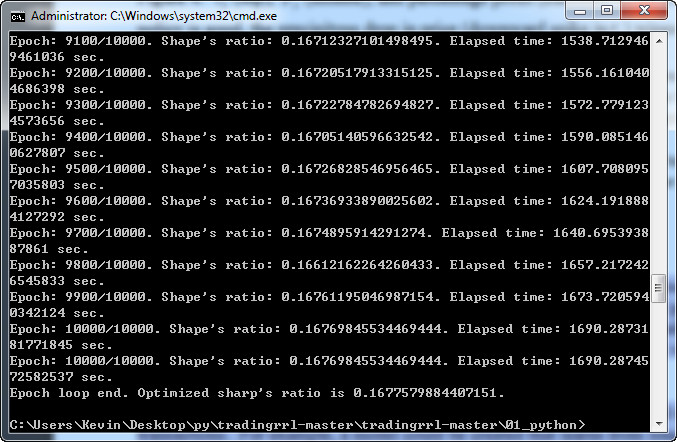一、简介
本项目是对论文《Stock Trading with Recurrent Reinforcement Learning (RRL)》的代码重现。
论文URL:http://cs229.stanford.edu/proj2006/Molina-StockTradingWithRecurrentReinforcementLearning.pdf
二、结论
先看结论吧:
这种方法的主要困难在于某些股票事件没有显示结构。从上面的第二个示例中可以看出,强化学习者无法预测股价的急剧下跌,并且像人类一样脆弱。如果与预测这种急剧下降的机制结合使用,可能会更有效。该模型还可以在其他方面作出修改,比如将成交量包含进来,作为预测涨跌的特征。
另外,可以尝试使用固定交易成本以及降低交易频率。例如,可以创建一个模型,该模型从长时间的数据中学习,但只能定期做出决策。这将反映一个散户交易者以固定交易成本参与较小数量交易的情况。因为对于散户而言,以固定的交易成本在每个期间进行交易都太昂贵了,所以具有定期交易策略的模型对于此类用户更为可行。
三、小知识
1.Sharp夏普比率的计算方法

四、代码
# -*- coding: utf-8 -*-
import time
import pickle
import numpy as np
import pandas as pd
from datetime import datetime as dt
import matplotlib.pyplot as plt
def main():
fname = "../data/USDJPY30.csv"
init_t = 6000
T = 1000
M = 200
mu = 10000
sigma = 0.04
rho = 1.0
n_epoch = 10000
# RRL agent with initial weight.
ini_rrl = TradingRRL(T, M, init_t, mu, sigma, rho, n_epoch)
ini_rrl.load_csv(fname)
ini_rrl.set_t_p_r()
ini_rrl.calc_dSdw()
# RRL agent for training
rrl = TradingRRL(T, M, init_t, mu, sigma, rho, n_epoch)
rrl.all_t = ini_rrl.all_t
rrl.all_p = ini_rrl.all_p
rrl.set_t_p_r()
rrl.fit()
# Plot results.
# Training for initial term T.
plt.plot(range(len(rrl.epoch_S)),rrl.epoch_S)
plt.title("Sharp's ratio optimization")
plt.xlabel("Epoch times")
plt.ylabel("Sharp's ratio")
plt.grid(True)
plt.savefig("sharp's ratio optimization.png", dpi=300)
plt.close
fig, ax = plt.subplots(nrows=3, figsize=(15, 10))
t = np.linspace(1, rrl.T, rrl.T)[::-1]
ax[0].plot(t, rrl.p[:rrl.T])
ax[0].set_xlabel("time")
ax[0].set_ylabel("USDJPY")
ax[0].grid(True)
ax[1].plot(t, ini_rrl.F[:rrl.T], color="blue", label="With initial weights")
ax[1].plot(t, rrl.F[:rrl.T], color="red", label="With optimized weights")
ax[1].set_xlabel("time")
ax[1].set_ylabel("F")
ax[1].legend(loc="upper left")
ax[1].grid(True)
ax[2].plot(t, ini_rrl.sumR, color="blue", label="With initial weights")
ax[2].plot(t, rrl.sumR, color="red", label="With optimized weights")
ax[2].set_xlabel("time")
ax[2].set_ylabel("Sum of reward[yen]")
ax[2].legend(loc="upper left")
ax[2].grid(True)
plt.savefig("rrl_train.png", dpi=300)
fig.clear()
# Prediction for next term T with optimized weight.
# RRL agent with initial weight.
ini_rrl_f = TradingRRL(T, M, init_t-T, mu, sigma, rho, n_epoch)
ini_rrl_f.all_t = ini_rrl.all_t
ini_rrl_f.all_p = ini_rrl.all_p
ini_rrl_f.set_t_p_r()
ini_rrl_f.calc_dSdw()
# RRL agent with optimized weight.
rrl_f = TradingRRL(T, M, init_t-T, mu, sigma, rho, n_epoch)
rrl_f.all_t = ini_rrl.all_t
rrl_f.all_p = ini_rrl.all_p
rrl_f.set_t_p_r()
rrl_f.w = rrl.w
rrl_f.calc_dSdw()
fig, ax = plt.subplots(nrows=3, figsize=(15, 10))
t_f = np.linspace(rrl.T+1, rrl.T+rrl.T, rrl.T)[::-1]
ax[0].plot(t_f, rrl_f.p[:rrl_f.T])
ax[0].set_xlabel("time")
ax[0].set_ylabel("USDJPY")
ax[0].grid(True)
ax[1].plot(t_f, ini_rrl_f.F[:rrl_f.T], color="blue", label="With initial weights")
ax[1].plot(t_f, rrl_f.F[:rrl_f.T], color="red", label="With optimized weights")
ax[1].set_xlabel("time")
ax[1].set_ylabel("F")
ax[1].legend(loc="lower right")
ax[1].grid(True)
ax[2].plot(t_f, ini_rrl_f.sumR, color="blue", label="With initial weights")
ax[2].plot(t_f, rrl_f.sumR, color="red", label="With optimized weights")
ax[2].set_xlabel("time")
ax[2].set_ylabel("Sum of reward[yen]")
ax[2].legend(loc="lower right")
ax[2].grid(True)
plt.savefig("rrl_prediction.png", dpi=300)
fig.clear()
class TradingRRL(object):
def __init__(self, T=1000, M=200, init_t=10000, mu=10000, sigma=0.04, rho=1.0, n_epoch=10000):
self.T = T
self.M = M
self.init_t = init_t
self.mu = mu
self.sigma = sigma
self.rho = rho
self.all_t = None
self.all_p = None
self.t = None
self.p = None
self.r = None
self.x = np.zeros([T, M+2])
self.F = np.zeros(T+1)
self.R = np.zeros(T)
self.w = np.ones(M+2)
self.w_opt = np.ones(M+2)
self.epoch_S = np.empty(0)
self.n_epoch = n_epoch
self.progress_period = 100
self.q_threshold = 0.7
def load_csv(self, fname):
tmp = pd.read_csv(fname, header=None)
tmp_tstr = tmp[0] +" " + tmp[1]
tmp_t = [dt.strptime(tmp_tstr[i], '%Y.%m.%d %H:%M') for i in range(len(tmp_tstr))]
tmp_p = list(tmp[5])
self.all_t = np.array(tmp_t[::-1])
self.all_p = np.array(tmp_p[::-1])
def quant(self, f):
fc = f.copy()
fc[np.where(np.abs(fc) < self.q_threshold)] = 0
return np.sign(fc)
def set_t_p_r(self):
self.t = self.all_t[self.init_t:self.init_t+self.T+self.M+1]
self.p = self.all_p[self.init_t:self.init_t+self.T+self.M+1]
self.r = -np.diff(self.p)
def set_x_F(self):
for i in range(self.T-1, -1 ,-1):
self.x[i] = np.zeros(self.M+2)
self.x[i][0] = 1.0
self.x[i][self.M+2-1] = self.F[i+1]
for j in range(1, self.M+2-1, 1):
self.x[i][j] = self.r[i+j-1]
self.F[i] = np.tanh(np.dot(self.w, self.x[i]))
def calc_R(self):
self.R = self.mu * (self.F[1:] * self.r[:self.T] - self.sigma * np.abs(-np.diff(self.F)))
def calc_sumR(self):
self.sumR = np.cumsum(self.R[::-1])[::-1]
self.sumR2 = np.cumsum((self.R**2)[::-1])[::-1]
def calc_dSdw(self):
self.set_x_F()
self.calc_R()
self.calc_sumR()
self.A = self.sumR[0] / self.T
self.B = self.sumR2[0] / self.T
self.S = self.A / np.sqrt(self.B - self.A**2)
self.dSdA = self.S * (1 + self.S**2) / self.A
self.dSdB = -self.S**3 / 2 / self.A**2
self.dAdR = 1.0 / self.T
self.dBdR = 2.0 / self.T * self.R
self.dRdF = -self.mu * self.sigma * np.sign(-np.diff(self.F))
self.dRdFp = self.mu * self.r[:self.T] + self.mu * self.sigma * np.sign(-np.diff(self.F))
self.dFdw = np.zeros(self.M+2)
self.dFpdw = np.zeros(self.M+2)
self.dSdw = np.zeros(self.M+2)
for i in range(self.T-1, -1 ,-1):
if i != self.T-1:
self.dFpdw = self.dFdw.copy()
self.dFdw = (1 - self.F[i]**2) * (self.x[i] + self.w[self.M+2-1] * self.dFpdw)
self.dSdw += (self.dSdA * self.dAdR + self.dSdB * self.dBdR[i]) * (self.dRdF[i] * self.dFdw + self.dRdFp[i] * self.dFpdw)
def update_w(self):
self.w += self.rho * self.dSdw
def fit(self):
pre_epoch_times = len(self.epoch_S)
self.calc_dSdw()
print("Epoch loop start. Initial sharp's ratio is " + str(self.S) + ".")
self.S_opt = self.S
tic = time.clock()
for e_index in range(self.n_epoch):
self.calc_dSdw()
if self.S > self.S_opt:
self.S_opt = self.S
self.w_opt = self.w.copy()
self.epoch_S = np.append(self.epoch_S, self.S)
self.update_w()
if e_index % self.progress_period == self.progress_period-1:
toc = time.clock()
print("Epoch: " + str(e_index + pre_epoch_times + 1) + "/" + str(self.n_epoch + pre_epoch_times) +". Shape's ratio: " + str(self.S) + ". Elapsed time: " + str(toc-tic) + " sec.")
toc = time.clock()
print("Epoch: " + str(e_index + pre_epoch_times + 1) + "/" + str(self.n_epoch + pre_epoch_times) +". Shape's ratio: " + str(self.S) + ". Elapsed time: " + str(toc-tic) + " sec.")
self.w = self.w_opt.copy()
self.calc_dSdw()
print("Epoch loop end. Optimized sharp's ratio is " + str(self.S_opt) + ".")
def save_weight(self):
pd.DataFrame(self.w).to_csv("w.csv", header=False, index=False)
pd.DataFrame(self.epoch_S).to_csv("epoch_S.csv", header=False, index=False)
def load_weight(self):
tmp = pd.read_csv("w.csv", header=None)
self.w = tmp.T.values[0]
def plot_hist(n_tick, R):
rnge = max(R) - min(R)
tick = rnge / n_tick
tick_min = [min(R) - tick * 0.5 + i * tick for i in range(n_tick)]
tick_max = [min(R) + tick * 0.5 + i * tick for i in range(n_tick)]
tick_center = [min(R) + i * tick for i in range(n_tick)]
tick_val = [0.0] * n_tick
for i in range(n_tick ):
tick_val[i] = len(set(np.where(tick_min[i] < np.array(R))[0].tolist()).intersection(np.where(np.array(R) <= tick_max[i])[0]))
plt.bar(tick_center, tick_val, width=tick)
plt.grid()
plt.show()
if __name__ == "__main__":
main()
运行截图:

可参考:
https://zhuanlan.zhihu.com/p/36632686
代码地址:https://github.com/darden1/tradingrrl

